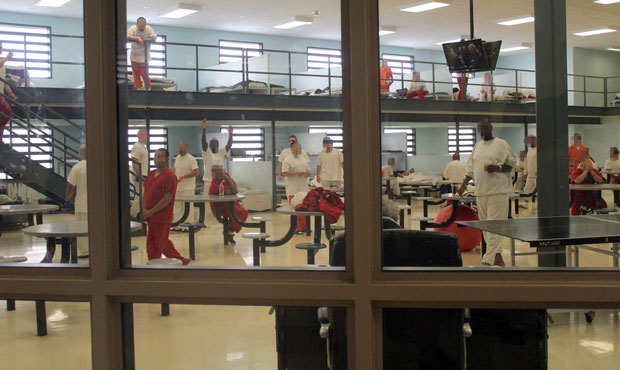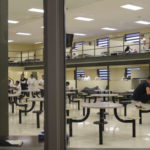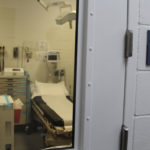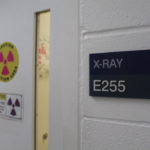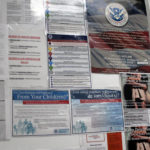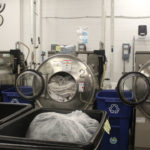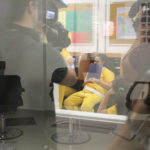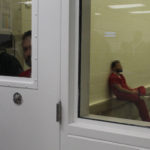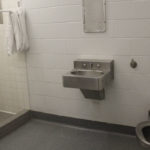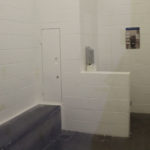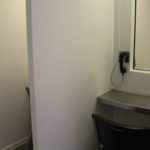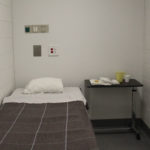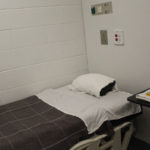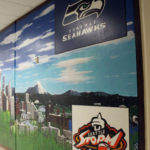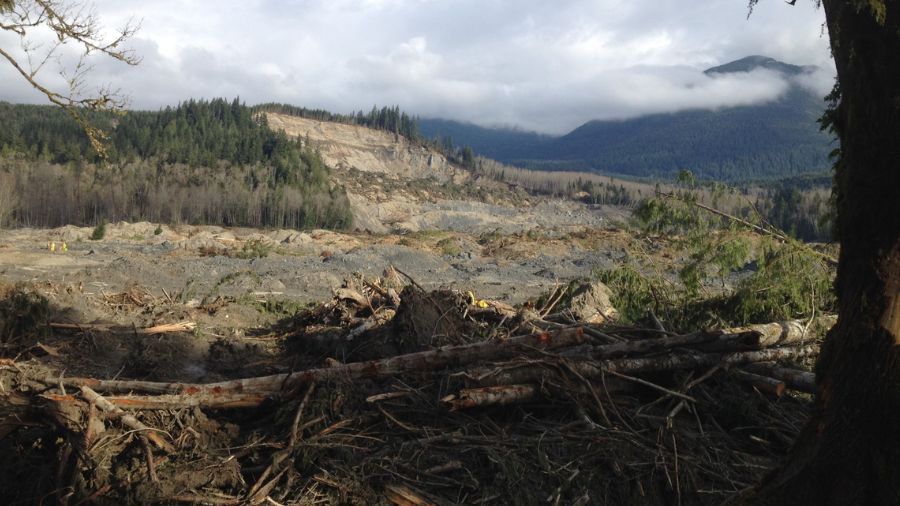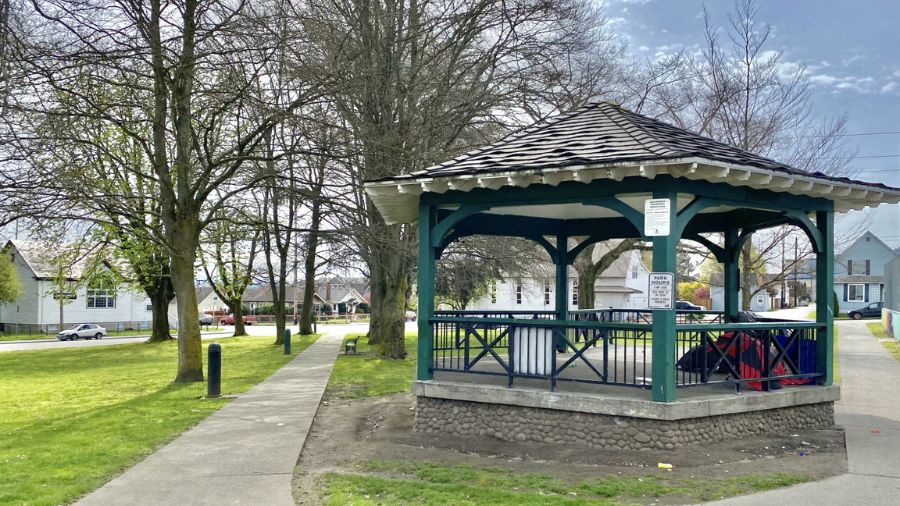ICE offers rare tour of Tacoma immigration detention to show ‘humane’ conditions
Sep 11, 2019, 1:08 PM | Updated: 2:09 pm
In an industrial area just blocks from downtown Tacoma, you’ll find a massive low-slung building called the Northwest Detention Center. It’s a processing facility for Immigration and Customs Enforcement, or ICE.
Seattle Field Operations Director Nathalie Asher invited media for a tour of the facility, she says, to dispel rumors about what they do. She sees this summer as an ugly turning point in the immigration debate. A protester showed up at their doorstep in Tacoma in July and tried to firebomb the facility. He was fatally shot by Tacoma police officers.
Asher says workers at the facility have also been targeted.
Man sent manifesto before he was killed at detention center: ‘i am antifa’
“People are receiving postcards in mail from organizations who don’t care for our mission, to tell them ‘we know where you work and we’re watching what you’re doing,'” Asher said. “We have employees that are sort of encountered as they’re trying to leave the premises. These are just individuals who come to work every day. They do, you know, what is asked of them. And those are the types of things — the public safety issues — just the mis-perception to the community, is so imperative that we re-calibrate and fix.”
Asher oversees the privately-run center and has spent many years of her career there, moving up through the ranks.
What is the Northwest Detention Center?
Also called the Northwest ICE Processing Center, it was opened in 2004 and is privately owned and operated by the GEO Group, a government contractor. ICE oversees and inspects the facility regularly.
According to fact sheets provided during the tour, it can house 1,575 men and women — no children — and was at about 85 percent capacity at the time.
Asher says this is not the same kind of facility often described in wrenching news reports, where people are crowded and sleeping in tents or surrounded by chainlink fences.
“Those are Border Patrol holding,” Asher said. “They were never designed for long-term detention. Right? They were just designed to be processed and then released while they await their proceedings, or transferred to ICE custody.”
Approximately 65 percent of the population in the Northwest Detention Center has a “non-criminal” background; they were detained at the southern border and transferred to Washington to await the outcome of their immigration cases. About 30 percent of those detainees, according to Asher, are from Mexico, the next largest group is from India, and then the “northern triangle” of Central America.
It appeared some preparations had been made for a media tour when journalists were guided through the facility this week. I could smell fresh paint in some of the hallways. Most of the men looked like they had fresh haircuts. The facility was clean, organized, and quiet.
The tour was pre-planned and limited. Reporters were not allowed to speak with detainees or staff, only look at conditions inside. It wasn’t to debate immigration law or policy. The tour of the Northwest Detention Center should not be seen as a blanket statement about conditions elsewhere.
Intake process
Detainees are first processed and screened for criminal background and gang affiliations, which helps sort them into housing. Every person goes through an initial health screening.
“They get that immediate medical screening,” Asher said. “Women, as they are all coming in, they are all taking a pregnancy test. On the occasion, someone doesn’t know they’re pregnant until we tell them. So, you know, on the occasion that can happen.”
Written guidelines say detainees dictate a schedule for medical care at 12, 24, and 72 hours after booking, then a “comprehensive” health assessment in 14 days. There are more guidelines for psychiatric patients, dental, and vision care.
Healthcare at the facility has been criticized for years as inadequate. But with 80 medical professionals assigned to the Northwest ICE Processing Center, Asher argues that detainees have some of the best care in the country when compared to similar facilities.
“For so many of these individuals, they don’t even know what good vision is,” she said. “For so many of them that have never had an eye exam. We issue glasses here. Sometimes people forget their glasses and while they’re waiting for the prescription we try to find glasses so they can see.”
Asher notes that caring for detainees has gotten tougher under Washington’s sanctuary state laws, which have barred ICE from working with certain public healthcare facilities, like psychiatric hospitals.
After initial intake, detainees are issued essentials like clothing, shoes, a bedroll, and hygiene products. They also get color-coded sweats they are required to wear when out of their living “pods.”
“They have uniforms assigned to them by classification level,” Asher said. “From the blue to the red, these are assigned to the males. Blue, being lowest — these are your non-criminals. For example, this would be an individual who, perhaps, was a southwest border-crosser. A non-criminal seeking asylum, as an example. The next level is green, then we have individuals who have a mid-level criminal history — orange — and then red is aggravated felons, the real bad guys, the gangs and whatnot.”
Women wear yellow, for non-criminal, and pink for high-threat detainees.
The GEO Group, which runs the facility, says it provides an orientation and a detainee handbook. A copy handed out to journalists is 39 pages long and addresses everything from telephone access to procedures for reporting sexual assaults.
The visitation area is small. Detainees and visitors communicate through phones, separated by thick glass.
There’s also a law library, which detainees can visit for an hour a day. When they first arrive, they’re given an orientation by non-governmental organizations that partner with the detention center. The library itself has a bank of desks and computers updated every three months with the latest Lexis Nexis law files. It was packed when the press tour moved through.
The hallways are referred to as a “gray mile.” They lead to the kitchen. The food has been another point of protest. Many detainees have gone on hunger strikes to protest poor food. Activists at the door told us they’d heard from detainees who’d found maggots in their meals.
Asher says she hasn’t heard reports of maggots. She says meal plans are written by dietitians and designed to provide 3,000 calories a day. The facility doesn’t serve pork, and provides kosher and halal options — meals prepared according to Islamic law.
There is also an industrial laundry room. And a barber room — hair cuts are given by volunteer inmates every 30 days, upon request.
Male pod living area
Detainees are housed in groups with a similar criminal background — about 60 people in each group. The living area is sparse, with bunk areas set back against the walls and a large open space in the center with tables and amenities. Some men we saw were playing chess. Others slept. Some watched TV.
Guidelines dictate that detainees should have an hour of “rec time” outside. The press tour didn’t visit the yard, but Asher tells us there are both covered and uncovered activity areas, with space to play soccer.
Asher says detainees who sign up for voluntary work duty are responsible for many of the inner workings of the Northwest Detention Center. They work in the kitchens, they clean, and they cut hair. They’re paid one dollar a day — according to federal mandate — which can be put toward their commissary fund.
“You know, it gets them the extra ramen noodles that they want,” Asher said.
Activists say that work is not voluntary, and that any detainees who stop work are punished with solitary confinement. Washington’s State Attorney General Bob Ferguson is suing to force the GEO Group to pay minimum wage.
At least some of those workers, though, volunteered their artistic talents. The hallways of the otherwise gray and imposing facility are peppered with large, colorful murals painted by detainees — some signed with the flag of their home country.
“I know of at least one individual who was in our custody. He let us know of his talent, and he actually proposed this place could use some, something. Right? So, for several, for a couple of years he was here fighting his case. And so, all throughout the facility there are some remarkable pieces that he’s done.”
Asher doesn’t know what eventually happened to that artist and said that “He was probably deported.”
This is the first in a two part series. Tomorrow: a discussion with a man who had once been detained for four years at the Northwest Detention Center, and moved between other facilities.

